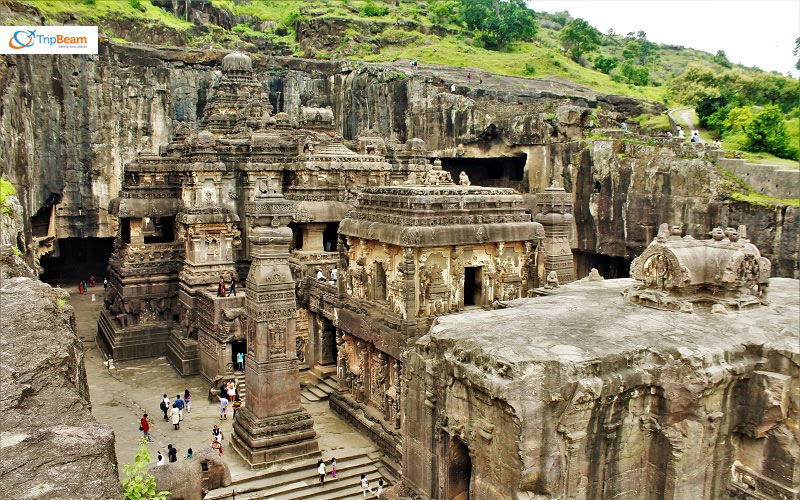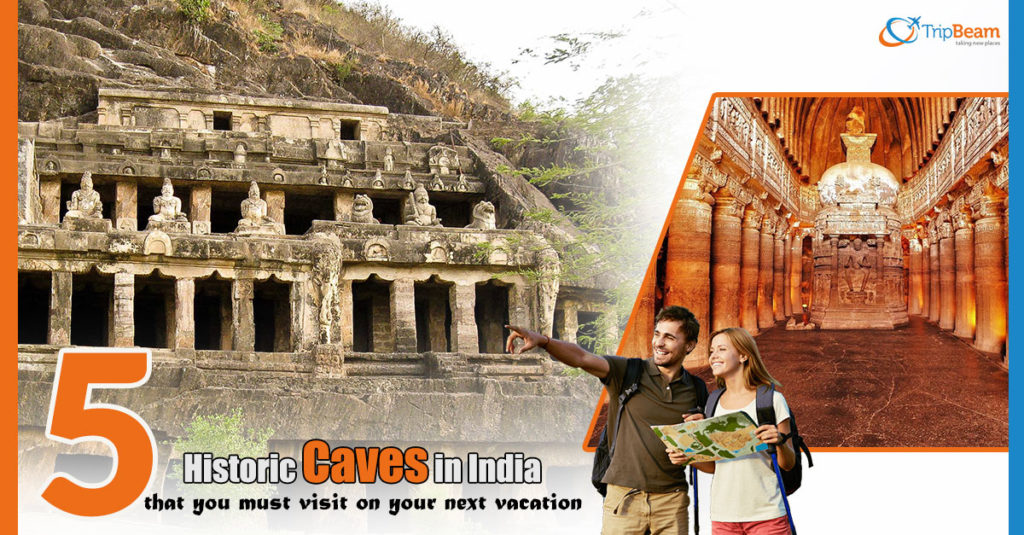India is home to one of the earliest civilizations in the world. The multicultural vibe is complemented by age-old wonders that continue to baffle historians and tourists alike. Hidden deeply inside verdant landscapes, the historic caves of India are visited by history buffs from around the globe. Interestingly, most of these caves contain Hindu, Buddhist, or Jain cave temples or sculptures, showing the evolutionary history of religion in the subcontinent. Some of these caves even date back to prehistoric times, giving a peek into the cultural facets and art in ancient India. Looking to travel to the ancient ruins of India? Get affordable flight tickets to India from Tripbeam to uncover the mysteries of these old caves.
Many of these ancient caves are UNESCO World Heritage Sites, attracting tourists from across the world. Take a look at the 5 alluring caves that stood the test of time and are a must-visit destination on your next vacation.
The Ajanta Ellora Caves


The biggest cave in India is also a UNESCO World Heritage Site. The 29 Ajanta caves are located in Waghur near Aurangabad and the rock-cut architecture of the Ajanta caves dates back to the 2nd century BCE. The caves contain Viharas and Buddhist monasteries and were built by the Vakataka Dynasty and Satavahana Dynasty. It is undoubtedly the highest point in Indian wall art paintings.
There are 34 caves at Ellora which date back to the 6th-11th century AD and are divided into three religious centers- Hinduism, Jainism, and Buddhism. The caves were built by Chalukya, Kalachuri, and Rashtrakuta rulers. The enigmatic wall paintings depict Buddhist Jataka tales or stories about the past lives of Buddha. The mesmerizing sculptures and epigraphic records from the caves give a glimpse into the wall paintings, architecture, and religious realities of ancient India.
Visit the enchanting Ajanta Ellora caves on your next trip to India. Browse online for affordable flight tickets to India and visit the historic UNESCO World Heritage Site this holiday season.
Varaha Cave Temple, Tamil Nadu- a UNESCO world heritage site:
The UNESCO World Heritage Site named “Group of Monuments at Mahabalipuram” includes the exquisite Varaha Cave Temple. Located on the Coromandel Coast, the cave temple is a perfect example of 7th-century Pallava Art. Narasimhavarman I Mahamalla built the structure in the Indian rock-cut style of architecture during his reign. The cave temple combines early Dravidian architecture with Buddhist designs.
The cave prominently features a sculpture of Lord Vishnu (incarnated as a wild boar) or Varaha, holding his wife Bhumi or mother Earth in his trunks, protecting her from the snake king Naga. Next to the Varaha stands Lord Brahma, Lord Shiva, and the sun and moon. Planning to make an early trip to this glorious World Heritage Site? Go online to get a travel package that includes cheap last minute flights.
The Elephanta Caves in Mumbai
The marvelous 7 rock-cut caves are located on Elephanta Island or the Island of Gharapuri and are a UNESCO World Heritage Site. A ferry ride from the Mumbai harbor provides access to the island. Builders created the rock-cut caves around the 6th century AD, with the main attraction depicting Lord Shiva in three forms – Vamadeva, Aghora, and Tatpurusha.
Hewn into a basalt rock structure, the site has two hills. On the west hills, you can find Hindu Shaivite sculptures from epics and mythology. Conversely, the Eastern hill contains a Buddhist stupa. If you’re an American tourist, you can find affordable flight tickets to India on Tripbeam. You can plan a quick visit to ‘Aamchi Mumbai’ this winter.
The Tabo Caves in Spiti, Himachal Pradesh
The unique Tabo caves are located near the 10th-century-old Tabo Monastery. Additionally, Royal Lama Yeshe-O founded the beautiful monastery in 996 AD. Furthermore, it houses precious murals, stucco sculptures, frescoes, and manuscripts of ancient Tibetan Buddhism.
Monks simply carved the caves out of hills and lined them with colorful Buddhist prayer flags, using the caves as assembly halls. Some meditating monks also used them as temporary dwellings during the harsh winters of the Spiti river valley. The unique caves overlook the lush green river valley and are a sight to behold! Planning to visit the unique Spitian landscape for a vacation? Go online and find travel sites that offer online cheap flights to India from USA to make a well-timed travel plan to the wonderland of Spiti valley.
Borra Caves, Visakhapatnam
Also known by the name Borra Guhalu, the alluring Borra caves are located in the Ananthagiri hills of the Araku Valley in the Visakhapatnam district of Andhra Pradesh. Limestone deposition built one of India’s largest caves.
Built of irregularly shaped stalactites and stalagmites formations, resembling Lord Shiva and Parvati, these mysterious caves are one of the deepest in the country. Furthermore, the entire area covers 1 square kilometer and enjoys popularity as a tourist destination.
History buffs, archeologists, and travel addicts love to explore a city’s modern and ancient vibe. Visiting these amazing prehistoric caves will open your eyes to the history of civilization in this part of the world. Most of these natural or man-made caves owe their origin to the spiritual practices of Hinduism, Jainism, and Buddhism and show the cultural fabric of India since prehistoric times.

